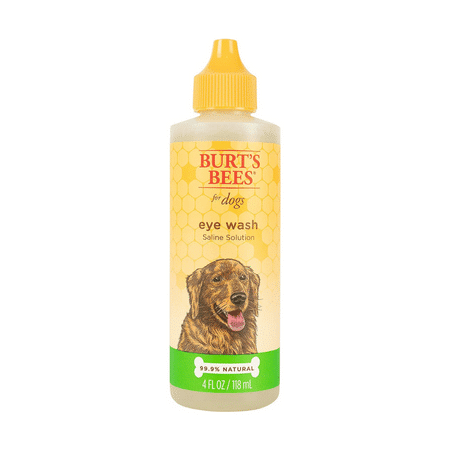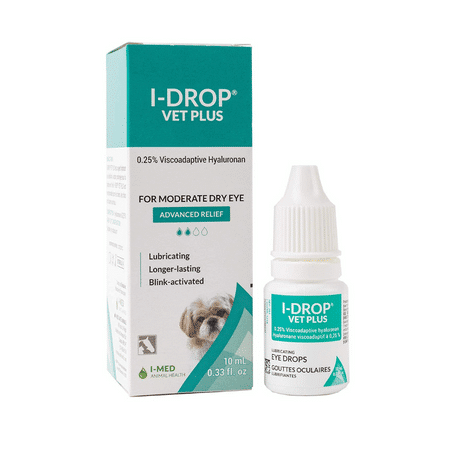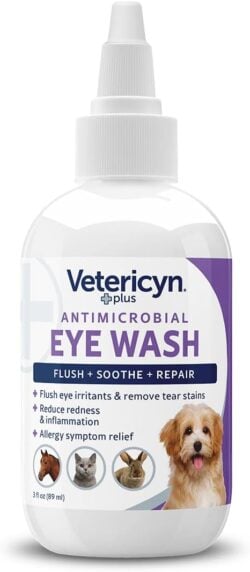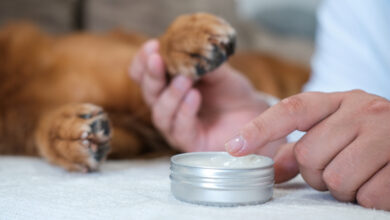Dog Pink Eye Home Remedy: When Is It Safe To Treat Your Pup’s Eye Issues At Home?
When you purchase through links on our site, we may earn a commission. Here’s how it works.
Pink eye in dogs, also known as conjunctivitis, is similar to that in humans, but it’s not as common in our canine counterparts. This condition is an itchy inflammation of the conjunctiva, the thin membrane that covers the eyeball and lines the eyelids.
Table of Contents
If you’ve ever had pink eye, you know how irritating it can be. The same is true for our furry friends. And we all want to help relieve them of any discomfort.
So, if your dog develops conjunctivitis, you may wonder if there’s a dog pink eye home remedy you can use to help your pup. I’ll share all the information you need — and when it’s time to see your veterinarian.
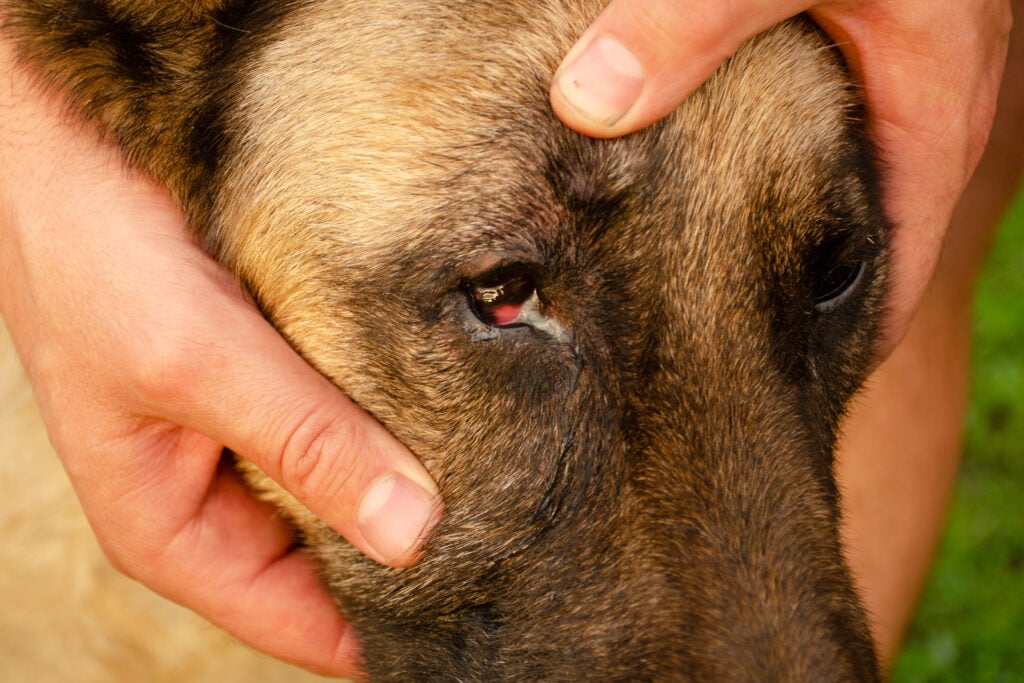
What Causes Pink Eye In Dogs?
Conjunctivitis in dogs has several causes, the most common being bacterial or viral infection, trauma, irritants in the eye, or allergies. Conjunctivitis can be infectious or non-infectious.
- Viruses: Canine distemper virus, canine herpesvirus, and adenovirus can cause pink eye in dogs.
- Bacteria: Staphylococcus and streptococcus are the most common types of bacteria that cause conjunctivitis in dogs. Both are highly contagious.
- Allergies: Allergic conjunctivitis can be caused by food or environmental allergies. They can also be seasonal.
- Injury: Cuts, scrapes, or other types of eye injuries can be caused by trauma, debris, or a foreign object.
- Dry eye: Keratoconjunctivitis sicca (KCS), also called dry eye, occurs when a dog’s eyes don’t produce enough tears. This lack of lubrication can cause inflammation and irritation, leading to pink eye.
Treatment depends on the underlying cause, so it can be difficult to know how to give your dog conjunctivitis home treatment without having your vet uncover the underlying cause.
Dog Pink Eye Symptoms
If you notice your dog has these symptoms, you should consult your veterinarian before using any home remedies for conjunctivitis in dogs. Many dog eye problems share similar symptoms, so it’s important to get a proper diagnosis.
- Squinting
- Sporadic blinking
- Redness of the eye
- Eye swelling
- Eye discharge and crustiness around the eye
- Eyelids sticking together
Contact your vet immediately if your dog’s eye seems very painful to the touch, looks cloudy, or appears to be bulging. These could be signs of serious issues like a corneal ulcer or glaucoma.
5 Home Remedies For Pink Eye In Dogs
If your canine companion’s eye is showing signs of conjunctivitis, it’s important to know what you can do safely at home to relieve itchiness, discomfort, or pain until you can get to your veterinarian.
You can use home remedies for conjunctivitis in dogs to clean the eye and help with discomfort, but they typically don’t treat the underlying medical problem.
If left untreated, eye problems, including conjunctivitis due to infections or trauma, could cause vision loss or even total blindness in the eye.
1. Warm & Cold Compresses
Both warm and cold compresses can provide relief for pink eye, but each serves a different purpose. You can use a warm compress to help loosen dried discharge and debris. A cold compress is better to help reduce swelling, itchiness redness, and discomfort. Apply for a few minutes at a time, several times a day.
2. Saline Solution
Using a saline eye wash can help clean your pup’s eye by flushing out dirt, debris, or other irritants. Saline eye washes may also provide some temporary relief for swelling and itchiness but aren’t effective in treating infections or injuries.
Burt’s Bees For Dogs Eye Wash is a fantastic option for puppies and adult dogs. It’s formulated without chemicals, phthalates, parabens, or sulfates. Be sure to hold the bottle one or two inches from your dog’s face and squirt in a few drops.
You can also make a homemade saline solution by dissolving half a teaspoon of non-iodized salt in one cup of boiled water. Allow it to cool before applying.
3. Lubricating Eye Drops
After cleaning your pup’s eye, you can use lubricating eye drops, like I-DROP VET PLUS, to help comfort dry, itchy, and irritated eyes. Again, these products don’t cure infections or resolve injuries,but they can provide a great deal of relief for dryness and irritation. Veterinarians often recommend lubricating eye drops, sometimes called artificial tears, along with prescription treatment.
4. Chamomile Tea Bag
A popular home remedy for human cases of pink eye, a steeped and cool chamomile tea bag placed on your dog’s closed eye may help relieve discomfort.
It’s believed that the anti-inflammatory properties in chamomile can help soothe irritation and reduce swelling, but getting your dog to hold still with their eye closed may be challenging.
Again, chamomile tea bags may provide some relief, but they don’t substitute for medical treatment, especially for eye infections or injuries.
5. Elizabethan Collar
An E-collar will help your dog’s eye heal properly by preventing them from pawing, rubbing, or scratching at it. If you’ve used a traditional Elizabethan collar before and your dog wasn’t a fan (most aren’t), you may want to check out my article reviewing the best dog cone alternatives that can offer more comfort.
Can I Use Over-The-Counter Medicated Solutions?
There are a handful of OTC medicated eye solutions available that may help ease symptoms. However, only use them with your vet’s approval.
Depending on the ingredients and the underlying problem causing pink eye, these solutions may do more harm than good — and could interfere with any other medications your pup is taking. Also, never use a product that’s not specifically formulated for pets.
A pet-safe option vets often recommend is Vetericyn Plus Antimicrobial Eye Wash, which can be used to flush out eye irritants, reduce eye redness and inflammation, ease allergy symptoms, and clean tear stains.
How Do Veterinarians Diagnose & Treat Conjunctivitis?
Your vet must perform a full eye examination to determine the cause and if damage to the eye has occurred. This may include tear-producing testing, corneal stain testing to identify scrapes or cuts, a bacterial culture, and viral testing.
Veterinarians typically recommend a cold compress, artificial tears/lubricating eye drops, and an Elizabethan collar for most cases of conjunctivitis. Additional treatment depends on the cause. See my article about eye drops for dogs for more details about the types of drops.
- Bacterial conjunctivitis: Antibiotic eye drops or ointment, steroid eye drops
- Viral conjunctivitis: Steroid eye drops
- Allergy-related conjunctivitis: Steroid eye drops, antihistamines, anti-inflammatory medication
- Injury: Medication (specific to the type of damage) and possible surgery
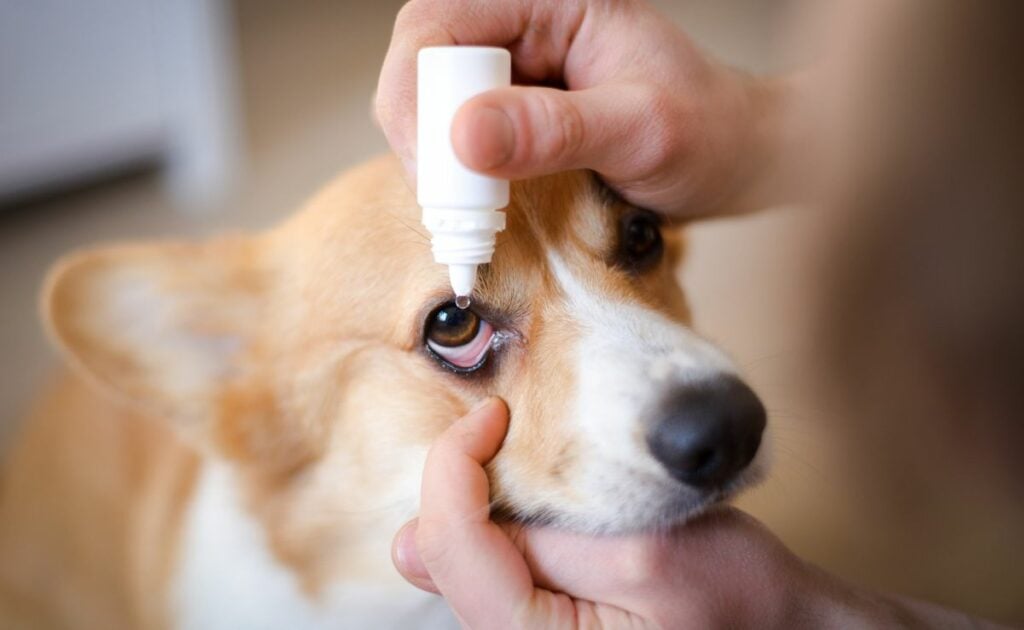
Frequently Asked Questions
Here are the questions pup owners ask most often about conjunctivitis in dogs and home treatment. If you don’t see yours here, please ask us in our comments.
How Long Does Conjunctivitis In Dogs Last?
It depends on the cause. If caused by a virus, conjunctivitis can take up to 3-4 weeks to recover from. Bacterial conjunctivitis is usually cleared up within 5 to 7 days once your pup starts the appropriate antibiotic treatment. Allergic conjunctivitis is usually recurrent until you and your vet discover the underlying cause. With trauma, it depends on the type of injury and if surgery is required.
What Other Eye Conditions Can Cause Or Mimic Symptoms Of Pink Eye?
Corneal ulcers, uveitis, glaucoma, eyelid abnormalities (entropion, ectropion, cherry eye), eye tumors, and other ocular disorders can either cause conjunctivitis or mimic the signs. All of these conditions can present with redness, discharge, and other similar symptoms that may be easily mistaken for conjunctivitis — unless you get a vet’s diagnosis.
How Can I Prevent Pink Eye In My Dog?
To help prevent pink eye in your dog, focus on maintaining a clean environment, keeping your dog’s eyes clean, ensuring vaccinations for viruses and are up-to-date, and avoiding potential irritants. Regularly check their eyes for any signs of irritation or discharge.
How Much Does Pink Eye Veterinarian Treatment Cost?
If you’re looking for home treatments because you’re worried about the cost of veterinary care, you’re certainly not alone. However, it’s often not wise to leave your dog’s health diagnosis and treatment on your shoulders. Treatment costs for eye problems can vary from a few hundred to several thousands of dollars. What can help?
Investing in a pet insurance policy can give you the ability to afford unexpected and expensive diagnosis and treatment procedures by covering a large portion of your vet bills for conditions that are not consider pre-existing. See our experts’ reviews of the best pet insurance providers to learn how pet insurance can help you protect your pup’s health and your finances.

